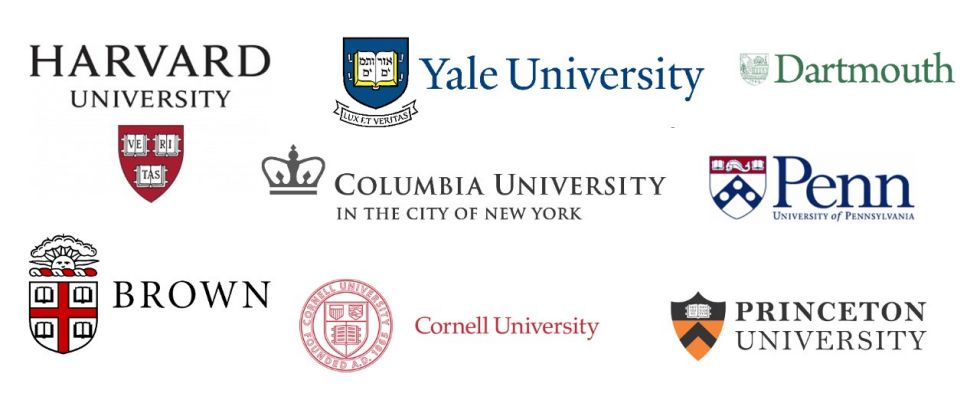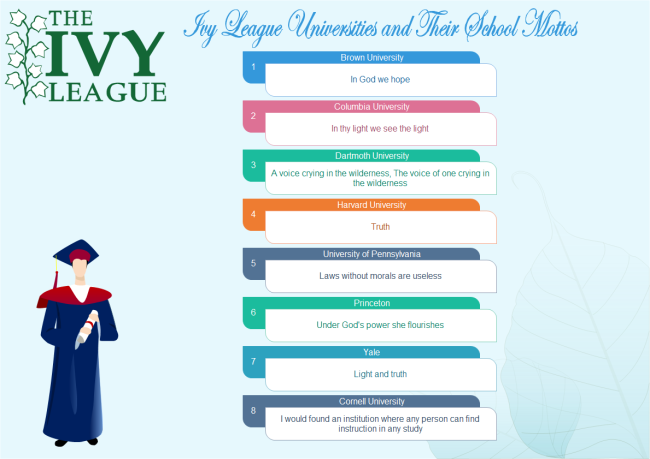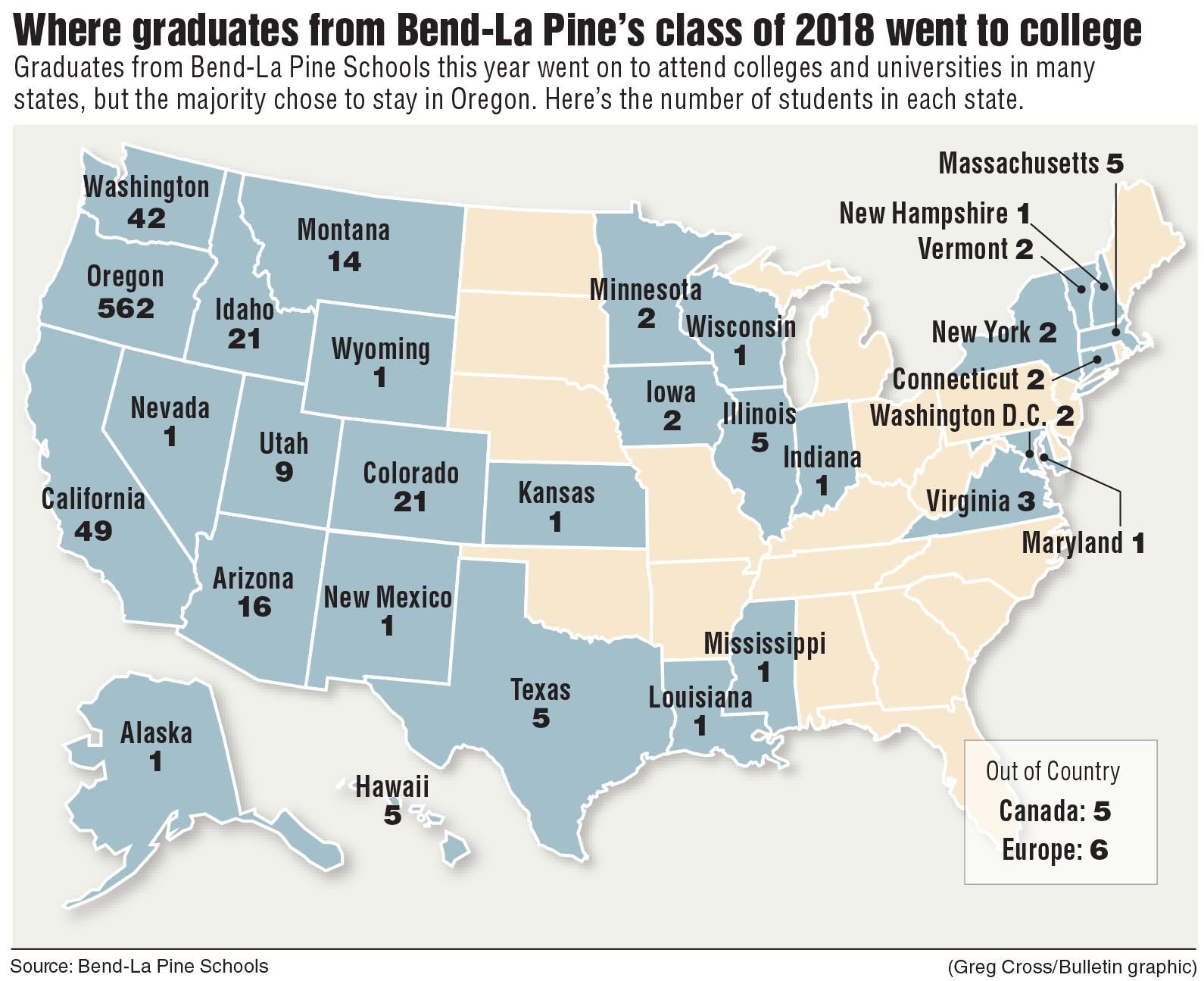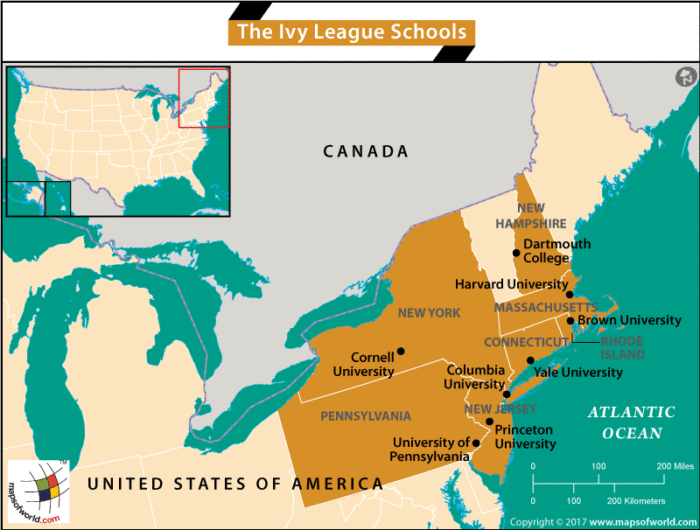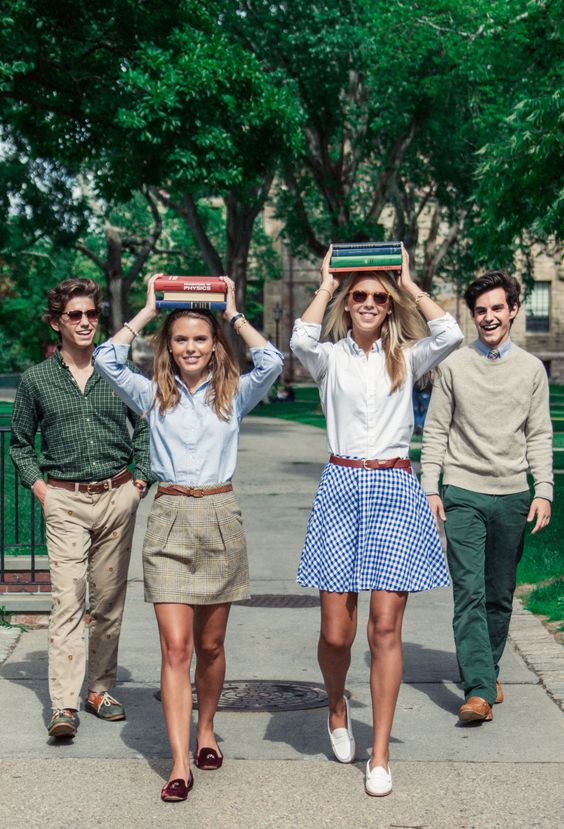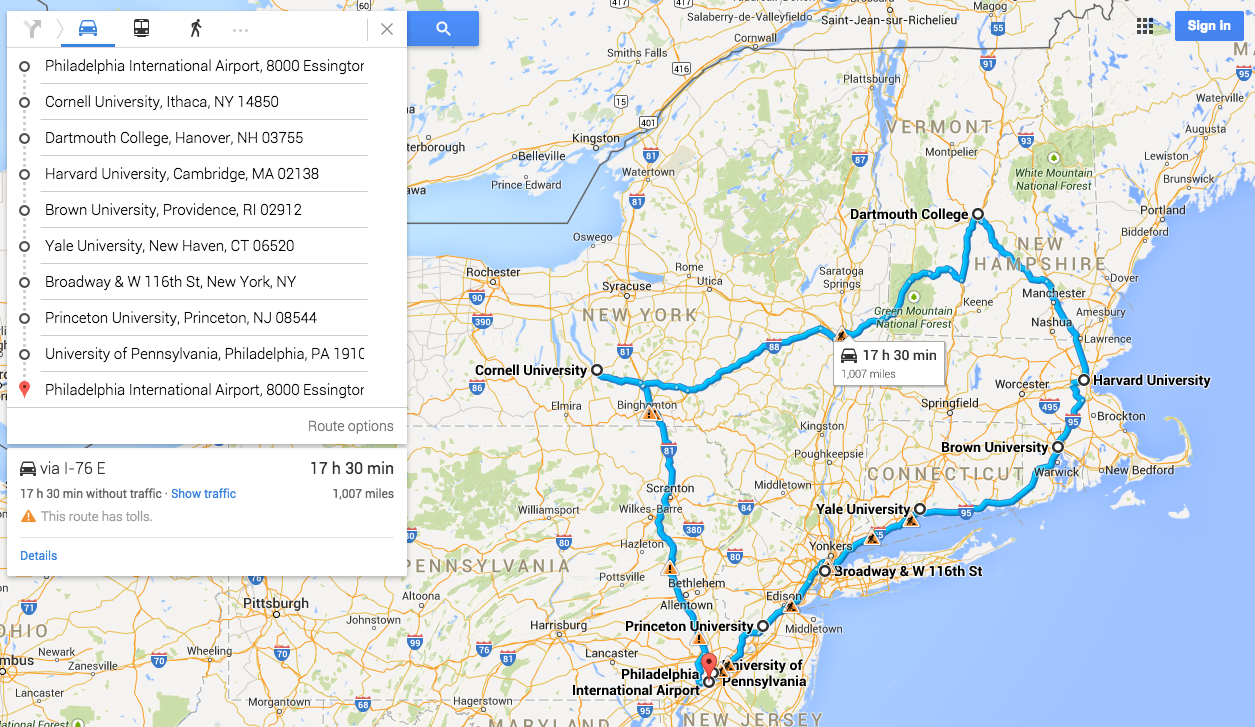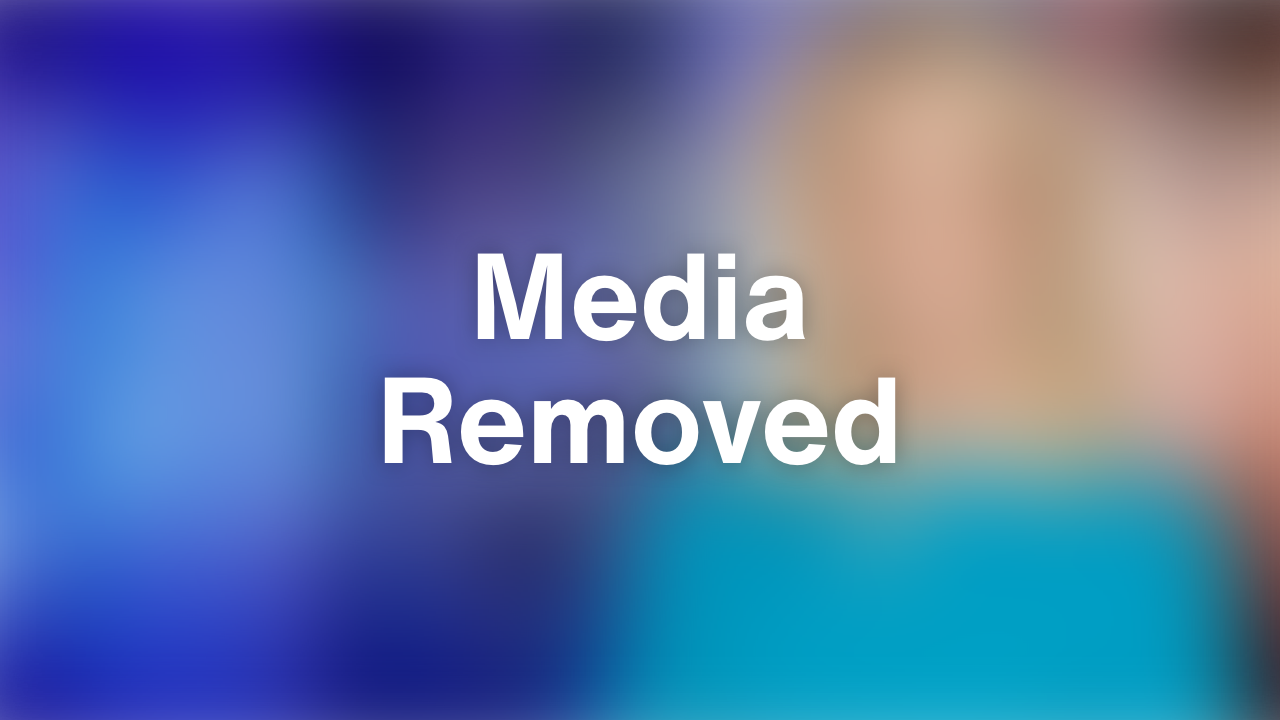The Ivy League is an athletic conference comprising eight private institutions of higher education in the Northeastern United States. The conference name is also commonly used to refer to those eight schools as a group. The eight institutions are Brown University, Columbia University, Cornell University, Dartmouth College, Harvard University, Princeton University, the University of Pennsylvania, and Yale University. The term Ivy League also has connotations of academic excellence, selectivity in admissions, and social elitism. In addition, Ivy League schools are often viewed by the public as some of the most prestigious universities worldwide and are often ranked amongst the best universities in the United States and worldwide. All of the Ivy League's institutions place within the top 15 of the U.S.
News & World Report college and university rankings; with five placing in the top six. As previously mentioned, far more students apply to Ivy League schools than are admitted to them. Overall, these colleges and universities have extremely competitive admission processes and quite low acceptance rates. While the average acceptance rate among ranked colleges reported by the U.S.
News & World Report was 68% in 2020, the acceptance rates for the Ivy League schools that same year ranged from 4.9% to 8.8%. What are the extra perks at small liberal arts colleges that even Ivy Leagues don't offer? Amherst College, for instance, offers the "Five College Consortium", where students can learn up to 27 different languages and take classes at any of the five participating colleges at no extra cost.
Swarthmore is part of the "Tri-College Consortium", with Bryn Mawr and Haverford, where students can also take courses. In engineering which makes it unique in that students get the freedom to pick creative courses in a liberal arts environment alongside. And colleges such as Bowdoin keep student's SAT and ACT scores as optional on the college's application form, as they believe in assessing students on other variables rather than heavily relying on standardized test scores.
These are frequently called the "happiest schools of America", and for good reason. But there are many kinds of advantages that exist, and an Ivy League education is just one of those. Having the space to grow and explore is a luxurious advantage, and one that liberal arts colleges offer in spades.
At the most crucial and impressionable time of life, young people thrive among like-minded peers. Being surrounded by people having similar goals and interests is a wonderful way to thrive. This goes on to show that students have varying levels of not only interests but also goals - neither of which is reflective of their intellect. Expensive tuition and fees like these can make it difficult for many students to afford enrollment at Ivy League schools.
Many institutions do, however, try to supplement costs where possible. The colleges and universities with large endowments, for example, are often able to offer extensive scholarship opportunities to those who qualify. This, coupled with other financial aid options, can make it possible for individuals from limited means to apply and thrive in an Ivy League academic setting. These eight schools have a reputation for being highly selective during their admissions process. According to USA Today, these schools have some of the lowest acceptance rates of admissions, averaging less than 10 percent of students received an admissions offer. Harvard University received 39,494 applicants for the Class of 2021.
The prior year, the institution accepted a record low of 5.2 percent of applicants. Although it's important to always aim for the sky and dream big, setting realistic goals for yourself is just as important. Hundreds of colleges out there can deliver better education to admitted students than the Ivies. Many of these schools, like "Public Ivy" universities are also more accessible and offer lower tuition fees, considering how the Ivies do not offer applicants any merit-based financial aid (only need-based aid).
These institutions are home to some of the most cutting-edge facilities in the world, their faculty members are leaders in their fields, and their alumni are highly accomplished as well. Even though Ivy League schools have impeccable reputations, they do not produce the most students who ultimately earn doctorate degrees. According to a 2010 CBS Money Watch report, liberal arts schools dominated the top 10 list of students who eventually earned doctorates.
For example, liberal arts schools produced twice as many students with science doctorate degrees as compared to other institutions, including Ivy League schools. If you are planning to pursue a doctorate, you might look beyond Ivy League possibilities and examine additional opportunities. For it to be worth applying to any of these schools, you should be performing at a very high level academically. Even at the Ivies with acceptance rates above 8 percent , serious applicants have very impressive high school transcripts and test scores. At Cornell, for example, the average SAT score for admitted students is a 1480. Large endowments, nationally recognized reputations, expensive tuition and fees, and extremely low acceptance rates all contribute to the sense that these colleges and universities are out of reach for many students.
Penn students develop the intellectual connections they need to thrive in an ever-changing and complex world. Working with faculty across a flexible curriculum spanning 4 undergraduate and 12 graduate schools, students develop adaptable, well-rounded minds. The physical proximity of the university's resources make thinking and learning between departments and disciplines a part of everyday life at Penn.
From innovative dual degree programs that defy traditional academic boundaries to rigorous grounding in the liberal arts and sciences, Penn is fueled by an open and endless exchange of ideas. A main difference between Ivy League schools and regular liberal arts schools is their acceptance rates. Ivy League schools are notorious for having highly competitive acceptance rates, and according to a 2012 CNN Money Report, those rates are getting even lower. Harvard and Yale had 5.9 percent and 6.8 percent acceptance rates, respectively, and the Ivy League school with the highest acceptance rate was Cornell at 16.2 percent. Ivy League schools offer exceptional educational opportunities but so do many other colleges in the US and worldwide. Schools like Stanford, MIT, Rice, and CalTech are not Ivy League schools but often rank higher in specific programs than some Ivy League schools.
Many of them also offer lower tuitions and have higher acceptance rates. Consider your area of study and see if another top school provides opportunities that will help you succeed. All eight are in the top 20 for number of sports offered for both men and women among Division I schools. Unlike most Division I athletic conferences, the Ivy League prohibits the granting of athletic scholarships; all scholarships awarded are need-based . In addition, the Ivies have a rigid policy against redshirting, even for medical reasons; an athlete loses a year of eligibility for every year enrolled at an Ivy institution.
Additionally, the Ivies prohibit graduate students from participating in intercollegiate athletics, even if they have remaining athletic eligibility. The only exception to the ban on graduate students is that seniors graduating in 2021 are being allowed to play at their current institutions as graduate students in 2021–22. This was a one-time-only response to the Ivies shutting down most intercollegiate athletics in 2020–21 due to COVID-19.
Ivy League teams' non-league games are often against the members of the Patriot League, which have similar academic standards and athletic scholarship policies . The Ivy League is an American collegiate athletic conference comprising eight private research universities in the Northeastern United States. The term Ivy League is typically used beyond the sports context to refer to the eight schools as a group of elite colleges with connotations of academic excellence, selectivity in admissions, and social elitism.
Its members are Brown University, Columbia University, Cornell University, Dartmouth College, Harvard University, the University of Pennsylvania, Princeton University, and Yale University. Similar to a high GPA, high SAT or ACT scores demonstrate your academic aptitude to the admissions committee. An excellent way to gauge if your score is in the ballpark of where you need it to be for your application to an Ivy League school is to check its class profiles. Often, schools will list the average scores of all admitted students. These colleges are known for being selective in their admissions; since the year 2000, the acceptance rates at each of the universities is said to have varied from 6 to 16 percent. In fact, in the most recent academic year, seven of the eight Ivy League schools reported record-high applications; seven also reported record-low acceptance rates.
This is an often-asked question and before we answer it, it's important to take a close look at the term Ivy League institutions. The Ivy League refers to a collegiate athletic conference that sees participation from the sports teams of eight private universities in the Northeastern United States. The conference name is also commonly used to address those eight schools as a group outside the sports context. These eight schools are Brown University, Columbia University, Cornell University, Dartmouth College, Harvard University, the University of Pennsylvania, Princeton University, and Yale University.
10 faculties are offering undergraduate and graduate-level programs in fields differing from professional fields like law, medicine, and business to degrees in liberal arts and social studies. Being a private university, it is more costly than many well-ranked public universities in the United States. Home to many renowned and well-respected professors, these private colleges and universities provide students with superior academic experiences and promising career opportunities.
Graduates have gone on to become presidents, Supreme Court justices, Olympic medalists, and Nobel Prize winners. Admission is also exceedingly competitive, however, with more students submitting applications each year than can be accepted. There are eight Ivy League schools -- Brown, Columbia, Cornell, Dartmouth, Harvard, Pennsylvania, Princeton and Yale -- and each has the reputation for being highly competitive in academic standards and admissions policies. Debates over the value of an Ivy League education have carried on for decades, but many believe it's worth the money. There are several main differences between Ivy League schools and general liberal arts colleges, but you can receive an excellent education from either.
The institution was founded in 1746, making it the fourth oldest university in the United States. It is a medium-sized institution with around 5,000 undergraduate enrollments, and like Harvard, has an extremely competitive acceptance rate of only 5%. Some of its most popular degrees include computer engineering, public policy analysis, and economics. It is rated #2 of the best colleges in America to study political science and public policy analysis.
SAT grades range from 1440 to 1570 and ACT grades range between 32 and 35. Each Ivy League college has its own unique accomplishments that make it important. All carry a certain reputation with them, and each school has programs that excel primarily in the medical and law fields, making them some of the most sought-after schools in the world. Their admissions process is very selective, which helps the schools ensure that they only accept the best and brightest. Many famous people have graduated from Ivy League schools, including recent presidents George W. Bush, Bill Clinton, and Barack Obama. This prestige leads many to believe that these colleges are only for the wealthy and elite.
Often, companies look for Ivy League graduates as potential employees, usually preferred by law firms, medical facilities, and large corporations. It has long been coveted to have earned a degree from an Ivy League school. Today, there are other competitors that some claim to be just as good as their Ivy counterparts.
Some of these well-known schools include Duke University, Johns Hopkins, MIT, Vanderbilt, and Georgetown University, to name a few. The Ivy League schools are still excellent in both academia and in sports, and they have left a legacy of higher education with an exceptional track record and reputation to go along with them. The Ivy League schools are highly selective, with all schools reporting acceptance rates at or below approximately 10% or less at all of the universities. For the class of 2025, six of the eight schools reported acceptance rates below 6%. Admitted students come from around the world, although those from the Northeastern United States make up a significant proportion of students. In Yale's recent admissions cycle, 6.6% of applicants were accepted, which is around the average acceptance rate for all Ivy League schools combined.
Annually, the average tuition cost plus fees for a year of study at Yale is approximately $58,000. A Single Choice Early Action Plan is offered by Harvard, Princeton, and Yale. This plan does not require a commitment to matriculate, and students may apply to other colleges under those colleges' regular admission programs but not to another institution's Early Action or Early Decision program. Students admitted under Early Action will be sent a financial aid offer when they receive their acceptance decision if they have completed all of the required financial aid forms.
In a nutshell, while Ivy league colleges provide the necessary headstart to students in terms of brand-name, liberal arts colleges are no less and they provide opportunities for an all round development. It's for the students to look at the critical pointers discussed in this article and make informed choices in terms of the right fit. All of these benefits of smaller liberal arts colleges come at, on average, significantly lower costs than that of an Ivy League. For example, for a college like Williams, graduates earn an average Early Career Pay of $70,600 and an average Mid-Career Pay of $150,300, with the cost of attending with tuition being approximately $72,270 (according to payscale.com).
For Pomona, an average Early Career Pay is around $70,200, with a Mid-Career Pay averaging at about $131,300, and tuition being around $56,284. Compare this to Princeton, which offers an Early Career Pay of $81,800, and a Mid-Career Pay of $161,500, with tuition being around $75,500. The comparable pay scale versus tuition remains roughly the same for the smaller liberal arts colleges and the Ivy Leagues, meaning a great return on investment - so that should be one worry off potential students' minds. Liberal arts colleges, both private and public, are located all over the United States. If you prefer to live in a certain part of the country or want to stay close to home, the location of Ivy League schools might be a consideration.
Because all Ivy League schools are private universities, tuition costs are higher for students compared to their in-state public tuition alternatives. However, Ivy League schools also have the reputation for being generous with financial aid due to their large endowments. The truth is that Ivy League colleges don't always have the highest quality of instruction for undergraduate students.
Overall, they tend to be very focused on doing academic research to maintain their position at the forefront of academia. Professors may be less interested in teaching than they are in their personal projects; alternatively, schools may end up hiring tons of adjunct faculty to keep costs down. You could end up with a better learning experience at a small, highly selective college that exclusively enrolls undergraduate students because the professors are there primarily to teach.
As late as the 1960s many of the Ivy League universities' undergraduate programs remained open only to men, with Cornell the only one to have been coeducational from its founding and Columbia being the last to become coeducational. Before they became coeducational, many of the Ivy schools maintained extensive social ties with nearby Seven Sisters women's colleges, including weekend visits, dances and parties inviting Ivy and Seven Sisters students to mingle. This was the case not only at Barnard College and Radcliffe College, which are adjacent to Columbia and Harvard, but at more distant institutions as well. The movie Animal House includes a satiric version of the formerly common visits by Dartmouth men to Massachusetts to meet Smith and Mount Holyoke women, a drive of more than two hours.
Colleges at the top of such lists often are the hardest to get into. Low acceptance rates — less than 10% for the "best" schools — indicate those colleges receive far more applications than they have places for students. If you're living in the same state as a Public Ivy—or can establish residency near your school of choice before college—it's probably themost affordable wayto get an outstanding education.
